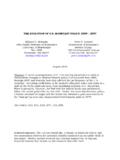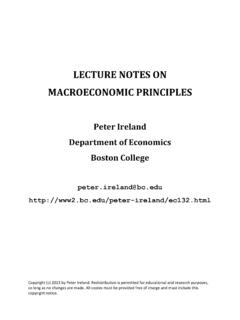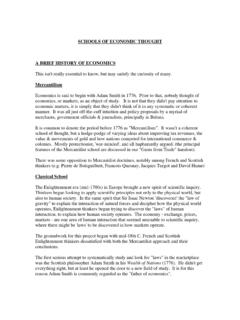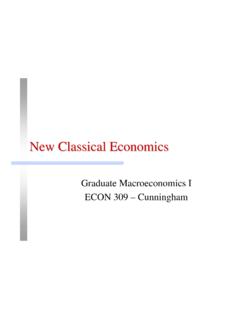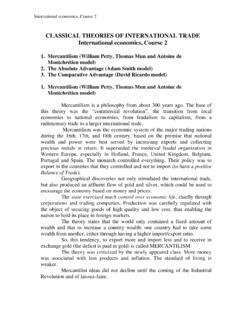Transcription of The Classical Theory of Inflation and Its Uses Today
1 The Classical Theory of Inflation and Its Uses Today Peter Ireland Boston College Shadow Open Market Committee Meeting New York, New York November 3, 2014. THE Classical Theory OF Inflation AND ITS USES Today . Peter Ireland1. Boston College and Shadow Open Market Committee October 2014. The Classical Theory : Why We Believe In It The Classical Theory of Inflation attributes sustained price Inflation to excessive growth in the quantity of money in circulation. For this reason, the Classical Theory is sometimes called the quantity Theory of money, even though it is a Theory of Inflation , not a Theory of money. More specifically, the Classical Theory of Inflation explains how the aggregate price level gets determined through the interaction between money supply and money demand.
2 As a matter of fact, because it traces the behavior of an important economy-wide variable Inflation back to the most basic forces of supply and demand, the Classical Theory must qualify as one of the oldest microfounded models in all of macroeconomics! Figure 1 presents the familiar diagram. The graph measures the quantity of money M. along the horizontal axis and the price of money 1/P along the vertical axis. This is the only tricky part: remembering that because the aggregate price level P measures the number of dollars that must be exchanged for each proverbial basket of goods, its inverse 1/P measures the number of baskets of goods that must be traded for each dollar.
3 Hence, 1/P is the price or value of a dollar in real terms. 1. Prepared for the November 2014 SOMC meeting. I would like to thank Michael Belongia for very helpful comments on an early draft of this paper and many useful discussions on topics related to those covered here, while retaining full responsibility for all errors, omissions, and misstatements that remain. In the graph, the money demand curve slopes down. Why? When the dollar price of a basket of goods goes up, each person must carry more money to make exactly the same purchases as before. Thus, when 1/P falls, the quantity of money demand rises. This means that in the graph, the demand curve must move to the right along the horizontal axis as its works its way down the vertical axis.
4 Suppose first that the central bank fixes the money supply at some level M0. An initial equilibrium prevails where money supply equals money demand: the graph shows that this requires the value of money to equal 1/P0 and hence the aggregate price level to be P0. Suppose next that the central bank takes policy actions to increase the quantity of money in circulation to M1. A new equilibrium is reached after the value of money falls to 1/P1 and the price level rises to P1. This, again, is the key implication of the Classical Theory : money growth causes Inflation . Thus, the Classical Theory allows us to think about Inflation without any reference to interest rates, unemployment, or any of the other variables that are more frequently referred to in popular discussions of Inflation and its causes Today .
5 This is a big part of what makes the Classical Theory of Inflation so useful. It recognizes that unemployment may be high or low and interest rates may be rising or falling it really doesn't matter. If the money supply is growing too fast, Inflation results. The Classical Theory is also useful because it reveals Inflation for what it truly is: a debasement of the currency an erosion in the purchasing power of money engineered through deliberate policy actions taken by the central bank. But as clean and aesthetically pleasing as its microfoundations might be, they are not the reason we all believe in the Classical Theory of Inflation .
6 Instead, we believe in the Classical Theory of Inflation because it enjoys more empirical support than any other Theory in all of 2. economics, except perhaps for the law of demand, which predicts correctly that when the price of an individual good goes up, people tend to buy less of it. In particular, the best and most convincing evidence in support of the Classical Theory is presented in famous studies like Sargent's (1982), which focus on the hyperinflationary episodes that have occurred in various places in various times throughout world economic history. In each and every one of these episodes, where Inflation rates in excess of 100 percent per year can be observed, these high rates of Inflation are inevitably accompanied by equally high rates of growth in the money supply.
7 And in each and every one of these episodes, the hyperinflation is seen to stop as soon as the central bank takes decisive action to restrain the monetary expansion. Thus, these episodes come close to being controlled, laboratory experiments in which the independent variable money growth is deliberately manipulated holding all else constant and the dependent variable Inflation changes in accordance with the predictions of Theory . Money Demand Instability: The Achilles Heel of Monetarism The empirical success of the Classical Theory ought to calm those who fear that, as it attempts to unwind the massive, unconventional policy actions it took to help stabilize the economy in the aftermath of the financial crisis, the Federal Reserve might allow the US Inflation rate to reach unacceptably high levels.
8 We don't have to worry about this because, according to the Theory , a noticeable acceleration in the growth rate of the broad monetary aggregates will presage such an outcome. Federal Open Market Committee members will then receive an early warning signal that they are falling behind the curve and can act more quickly to renormalize monetary policy, so that Inflation need not overshoot their two percent long-run target. 3. But while history has offered up numerous episodes that confirm the validity and relevance of the Classical Theory , painful experience has also shown that the Classical Theory serves much less well as a guide for decision-making at the six-week frequency with which FOMC meetings are held.
9 The biggest challenge to the Theory what Bernanke and Blinder (1988) call the Achilles heel of monetarism stems from money demand instability: right or leftward shifts in the money demand curve in figure 1 that generate unwanted volatility in prices and can, therefore, cause Inflation to deviate from target if the central bank keeps the money supply growing along a fixed, pre-set path. Regrettably, abrupt and often large shifts in econometric money demand specifications for the US have appeared repeatedly since the days of the missing money chronicled by Goldfeld (1976). For this reason, most economists would argue and I would tend to agree that it would be a bad idea for the Federal Reserve to go back to announcing specific, numerical targets for money growth the way it did as part of its regular reporting to Congress before the year Yet, to admit that the FOMC should not tie its meeting-by-meeting decisions too tightly to high-frequency observations of money growth rates is quite different from saying that the FOMC should ignore data on money growth altogether.
10 For one thing, alternative approaches to short-run policymaking that focus on unemployment, the output gap, or other measures of excess capacity or slack strategies similar, in fact, to those the FOMC seems to have re-adopted most recently have failed the Fed before, as work by Orphanides (2003) makes abundantly 2. I hedge here, however, because there are a number of studies, including Belongia (1996) and Hendrickson (2014), that show that much of the discrepancy between the observed behavior of the monetary aggregates and the predictions of monetary Theory disappears when the Federal Reserve's official measures are replaced in econometric models by the Divisia indices described below.

